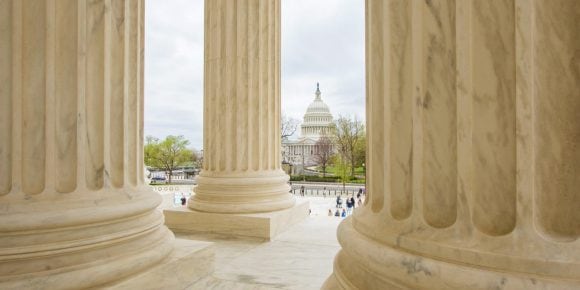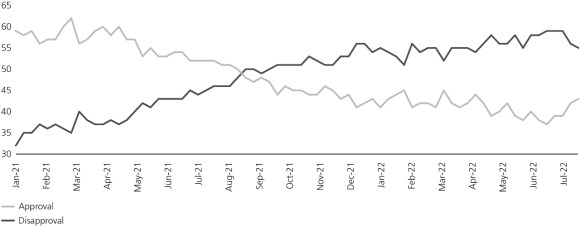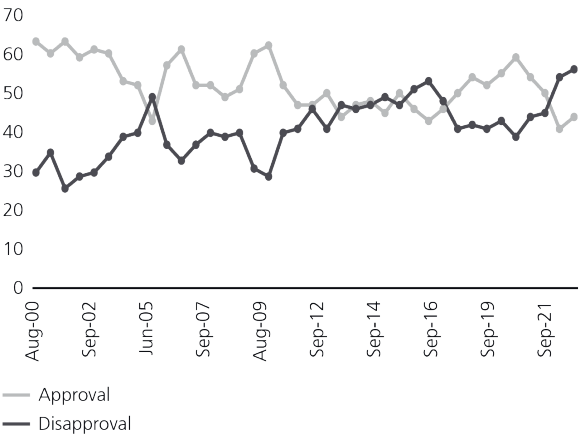Shifting fortunes
A consequential summer ahead of the 2022 US midterm elections

A consequential summer
A consequential summer
History suggests that the president’s political party should expect to lose some congressional seats in the midterm elections, which are viewed as a referendum on the performance of the chief executive. The popularity of the person holding the nation’s highest office tends to diminish after two years due in part to incessant media coverage which tends to amplify periodic gaffes. When the president’s job approval rating declines more precipitously than usual due to political blunders or policy mistakes, the party in power pays a heavier price at the polls.
The nexus is strongest in the House of Representatives, where the party affiliated with the Oval Office almost always loses seats.1 For recent examples, we need only reference the “shellacking” that House Democrats took in 2010 or the defeats suffered by their Republican counterparts eight years later.2 Senators enjoy a higher profile than members of the House of Representatives and tend to be more insulated from a decline in the personal appeal of the sitting president. The six-year term accorded senators under the constitution also plays a role, because the upper chamber’s most vulnerable members may not need to seek reelection in the middle of a presidential term.
We have discussed this dynamic in prior editions of ElectionWatch but reiterate it here because this year’s midterms—surprisingly—are shaping up to be more competitive than originally anticipated. Six months ago, as state primary elections were just getting underway, Republicans were expected to handily win a large majority of seats in the House and recapture control of the Senate. President Joe Biden’s personal popularity had not recovered from the chaotic US withdrawal from Afghanistan, and congressional Democrats were fighting among themselves over major tax legislation.
If a week is a long time in politics, then six months can seem like a lifetime. President Biden’s net job approval rating remains mired in negative territory, but Democrats are now favored to retain narrow control of the Senate. The GOP is still expected to flip enough seats in the House to regain a majority, but the expected margin is smaller than originally forecasted. The disparity between Biden’s low job approval rating and the optimism now voiced by Democrats is a striking summer development.
President Biden’s job approval rating (in%)

The heightened competitiveness is due to a variety of factors ranging from the nomination of inexperienced GOP candidates to a Supreme Court decision that has motivated Democrats and unaffiliated voters to turn out in greater numbers. Legislative successes in the form of the CHIPS and Science Act and the Inflation Reduction Act also may have played a role. The former, which enjoyed bipartisan support, provides USD 52 billion worth of subsidies and tax credits to encourage domestic production of semiconductors and another USD 170 billion for scientific research. The latter is wide-ranging and transformative, as discussed in detail below.
Voters react to Supreme Court decisions
Voters react to Supreme Court decisions
Alexander Hamilton asserted that an independent federal judiciary was bound to be the weakest of the three branches of government because it held “no influence over either the sword or the purse.”4 In hindsight, he underestimated the impact of Supreme Court decisions on American society. The court’s influence on the daily lives of American voters has increased markedly over time. The most recent term was no exception, having delivered important decisions on topics ranging from abortion and environmental regulation to gun control and religious expression.
By and large, the Supreme Court has been viewed with greater deference than either Congress or the presidency, which has tended to dampen criticism of the institution over longer time periods. That may be changing. According to Gallup, the court’s overall approval rating has been on a downward trajectory for more than 20 years.5 More ominously, the partisan divide appears to have widened.6 In a national poll conducted by Grinnell College in October 2021, 62% of the respondents believed that justices’ political views drive their decisions.7
As we discussed in our 21 April ElectionWatch report,“The balance of power,” voters tend to view midterm elections as a referendum on the incumbent president’s performance, and those affiliated with the opposition party are generally more motivated to cast a ballot. Recent Supreme Court decisions have the potential to provoke registered Democrats and unaffiliated registered voters, otherwise indifferent to an unpopular president, to vote in greater numbers than the historical pattern would suggest.
SCOTUS approval rates (in%)


